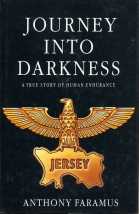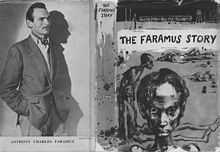Anthony Faramus

Anthony Charles Faramus was an actor and author who was born in Jersey in 1920 and died in Britain in 1990.
The autobiographical accounts of his survival of Fort de Romainville, Buchenwald and the Mauthausen-Gusen concentration camp complex were published as The Faramus Story in 1954 and Journey Into Darkness in 1990. Two books about Agent Zigzag, the double agent Eddie Chapman, also document aspects of Faramus’s imprisonment in Jersey, Paris and the concentration camps.
Arrested
Faramus worked as a hairdresser in a Saint Helier salon and later, during the early stages of the German occupation of the Channel Islands, was employed in the kitchen of the Miramar Hotel.
Under the conditions of military occupation, the administration of civil law and order was subject to the dictates of the German authorities, a state of affairs that some have described as collaboration. In December 1940 Faramus was arrested by the Jersey police, on the orders of the Feldgendarmerie, for an act of sabotage. The Jersey police had caught him in possession of an anti-Nazi leaflet and accused him of defrauding the state of ninety Occupation Marks. Faramus names Centenier Arthur Tostevin, an Honorary Police officer of St.Helier and Detective Constable Benjamin Shenton as the officials who had informed the Germans about his activities. He was sentenced to six months hard labour and incarcerated in H.M. Prison Jersey, sharing the same cell as Eddie Chapman. They arranged to meet-up after they were released from prison and consequently shared a flat. For a short period they ran a barber shop together. Their customers included civilians and German soldiers alike.
Deported
The authorities suspected Faramus and Chapman of further involvement in acts of sabotage and they were re-arrested by the police late one night in November 1941. As a political prisoner, Faramus was deported with Chapman by boat from St. Helier, Jersey to the port of Granville, in mainland Normandy, then in Occupied France. They were then taken by rail to Fort de Romainville in Paris where many people were interned before being deported to Auschwitz, Ravensbrück, Buchenwald and Dachau.
After a year, Faramus along with other prisoners from Romainville, was taken in terrible conditions by train via Compiègne onto the Buchenwald concentration camp near Weimar, Germany.
In chapter 7 of Journey Into Darkness, Faramus describes the crime for which he was taken out of the Buchenwald camp and forced on a journey to Mauthausen via Leipzig, Dresden and Prague.
...a freezing cold morning, at my place of work — ‘Kommando das Grab' (communal graves) — I had momentarily set aside my shovel to blow into my hands and fingers. I had not seen the approach of the SS Warrant Officer. Failing to acknowledge the man’s presence and not coming to attention and removing my cap from my head until he had passed by was one crime, the interruption of my work without permission was another. I was punched and booted; worse, my number (E)42324 was noted in his book of reports.
The Nazi Party defined Mauthausen as "Grade III". Its purpose was to punish "Incorrigible Political Enemies of the Reich" with extermination through labour.
In Journey Into Darkness Faramus acknowledges Captain Maurice Pertschuck[1] who was murdered in Buchenwald in 1944, Christopher Burney and Lt. Jack H. Taylor. In film footage [2] gathered by the US Department of Defense after the 11th Armored Division of the 3rd US Army entered the camp on the 5th of May 1945, Lt. Jack H. Taylor spoke about his capture, imprisonment and the conditions at Mauthausen. Faramus also mentions Pierre Serge Choumoff, a mathematician and engineer, imprisoned in Romainville and Mauthausen who later investigated the Mauthausen-Gusen complex.
Post-War

For over a year after the war Faramus lived in Paris as he searched for some of the women and men that he had known whilst imprisoned in Fort de Romainville. During this period he lost a lung following surgery for tuberculosis which he contracted during his imprisonment in Mauthausen. He returned to Britain and after a series of jobs in hotels and bars Faramus was able to find work as an extra in various films produced at Pinewood Studios.
Anthony Faramus emigrated to the USA with his wife Mary where they both had careers in the film industry. Faramus worked as an actor and played the roles of a British officer in The Colditz Story and a prisoner of war in King Rat. He also worked as Clark Gable’s butler and chauffeur. After living in California he and Mary moved back to Britain living in London and later in Farnham, Surrey.
In the 1970s he joined the Hunt Saboteurs Association an organisation whose aim is to disrupt blood sports using direct action tactics. In the late 1980s Faramus was arrested during a fracas at a hunt in Hampshire. He refused to be bound over to keep the peace and was sent to prison for a month.
Over a hundred people, including actors, hunt saboteurs and concentration camp survivors attended his funeral at St. Andrew's Parish Church in Farnham in 1990. Dave Wetton, one of the founders of the hunt Saboteurs Association in the 1960s read a funeral address. The huge variety of mourners, with large varieties of anti establishment youth, theatrical "luvvies" and elderly concentration camp veterans drew the attention of one Farnham resident - who could be heard to say: "There must be someone famous being buried."
Films
- King Rat (1965). Director: Bryan Forbes. Faramus plays role of a prisoner.
- The Colditz Story (1955). Director: Guy Hamilton. Faramus plays role of a British officer.
References
Notes
Bibliography
- Anthony Faramus. Journey Into Darkness. Foreword by Greville Janner. Grafton. (1990) ISBN 978-0-246-13490-5
- Anthony Faramus. The Faramus Story: Being the Experiences of Anthony Charles Faramus. Wingate (1954) ASIN B001AGMBMS
- Anthony Faramus. Hands of the Devil, (Digit) ASIN B000X8UH2U
- Ben Macintyre. Agent Zigzag. Bloomsbury (2007) ISBN 0-7475-8794-9
- Nicholas Booth Zigzag: The Incredible Wartime Exploits of Double Agent Eddie Chapman. Portrait ( 2007) ISBN 0-7499-5126-5
External links
|